| Ackerson Mead Clark House | |
|---|---|
 | |
| General information | |
| Address | Pequannock, New Jersey, U.S. |
The Ackerson Mead Clark House is a historic mansion in Pequannock, New Jersey listed on the New Jersey State Historic Register.
| Ackerson Mead Clark House | |
|---|---|
 | |
| General information | |
| Address | Pequannock, New Jersey, U.S. |
The Ackerson Mead Clark House is a historic mansion in Pequannock, New Jersey listed on the New Jersey State Historic Register.
| Library resources about Ackerson Mead Clark House |
Located at 183 Mountain Ave in Pequannock, NJ, the Ackerson Mead Clark House is a 21-room Greek Revival mansion built in the mid-1800s.
Although having a three-century history, the home wasn't included on the Register of Historic Sites maintained by the New Jersey Department of Environmental Protection until a decision was made on July 29, 1981. Despite extensive renovation in the early 2000s the front exterior Greek Revival colonnade, original staircase, 1870s fireplaces, and a wide variety of architectural details and moldings remain intact. Originally a plantation style structure located in an agrarian community, the property surrounding the private residence has been reduced to 1.37acres over decades of nearby development. [1]
Currently known as "Willow Manor," the mansion was listed for sale in 2011 at a list price of $1.4 million. [2]
The property is also considered a New Jersey Highlands Region Cultural Resource. [3]
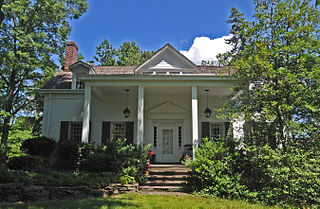
Pequannock Township is a township in Morris County, in the U.S. state of New Jersey. As of the 2020 United States census, the township's population was 15,571, an increase of 31 (+0.2%) from the 2010 census count of 15,540, which in turn reflected an increase of 1,652 (+11.9%) from the 13,888 counted in the 2000 census. The primary community in the township is the census-designated place of Pompton Plains.

Georgian Court University is a private Roman Catholic university in Lakewood Township, New Jersey. Founded in 1908 by the Sisters of Mercy, the university has more than 1,600 undergraduates and nearly 600 graduate students.

The Pompton River is a tributary of the Passaic River, approximately 8 miles (13 km) long, in northern New Jersey in the United States.

The Pequannock River is a tributary of the Pompton River, approximately 20 miles (32 km) long, located in northern New Jersey in the United States.

Springfield/Belmont is a neighborhood in the city of Newark in Essex County, in the U.S. state of New Jersey. Part of the Central Ward, it is unofficially bounded by South Orange Avenue in the north, Avon Avenue in the south, Martin Luther King Boulevard and University Avenue on the east, and Bergen Street in the west.
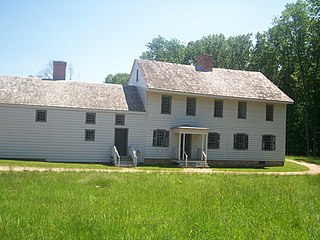
Rockingham is a historic house that was the home of John Berrien (1711–1772) and George Washington's final headquarters of the Revolutionary War. It is located at 84 Laurel Avenue, Franklin Township in Somerset County, New Jersey. The house was originally located on the hillside east of the Millstone River at Rocky Hill. It has been moved within southern Franklin Township several times, and is now closer to Kingston than to Rocky Hill. The residence is a featured part of the Millstone River Valley Scenic Byway. The oldest portion of the house was built as a two-room, two-story saltbox style house c. 1710; a kitchen and additional rooms were added on in the early 1760s, expanding with the Berrien family. The first reference to the house as "Rockingham" does not appear until a 1783 newspaper advertisement to sell the house, a name given most likely in honor of the Marquess of Rockingham.
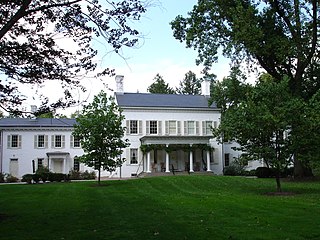
Morven, known officially as Morven Museum & Garden, is a historic 18th-century house at 55 Stockton Street in Princeton, New Jersey. It served as the governor's mansion for nearly four decades in the 20th century, and has been designated a National Historic Landmark for its association with Richard Stockton (1730-1781), a signer of the United States Declaration of Independence.

The Springfield Presbyterian Church is located on Morris Avenue in downtown Springfield, New Jersey, United States. It was first established in 1745.
Bergen-Lafayette is a section of Jersey City, New Jersey.

The Martin Berry House is located in Pompton Plains in Pequannock Township, Morris County, New Jersey, United States. The house was built in 1720 and documented by the Historic American Buildings Survey (HABS) in 1939. It was added to the National Register of Historic Places on June 19, 1973, for its significance in architecture and settlement. Built by the son of one of the first settlers to the Pompton River region, the pre-Revolutionary War building has been little altered since its construction.
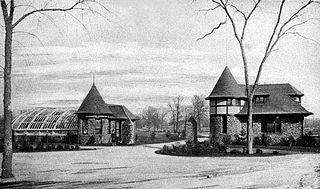
Halcyon Park is an unincorporated community that was developed by Reverend Cyrus Kemper Capron in Bloomfield, in Essex County, in the U.S. state of New Jersey, in 1895 as a planned community of homes with trees and shrubs, picturesque cottages, ponds and common grounds to be maintained by a caretaker and gardener. It is believed that Halcyon Park was inspired by Llewellyn Park, the first planned garden suburb about three miles away. Capron envisioned a private residential park for individuals of moderate means to offer all the advantages of the city and the country. The original plan laid out 182 lots and common grounds to include a club house and tennis courts for common use by a lot-owners association. The Club House contained a bowling alley, billiard table, library and stage. The common grounds included a gate house, a conservatory, and two ponds. The land was developed with water, sewer and gas lines and paved streets, innovative at the time.
Bank Barn was item #2219 on the New Jersey State Historic Register, a timber bank barn located at 207 Mountain Avenue in Pequannock, New Jersey.
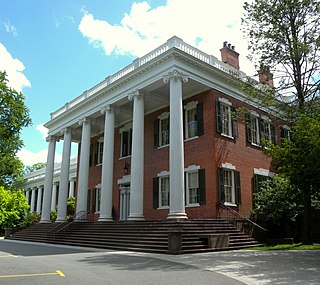
Gibbons Mansion, currently known as Mead Hall, is a historical mansion on Drew University campus in Madison, Morris County, New Jersey, United States. It houses the university's administrative offices today.

Saint John's Episcopal Church in Jersey City, New Jersey is a disused church of the Episcopal Diocese of Newark. Located on Summit Avenue in Bergen Hill, it is considered a masterwork of 19th-century ecclesiastical architecture. The building, which was named a municipal landmark in 2013, has not housed a congregation since 1994, and has fallen into disrepair. There are proposals to convert the buildings on the grounds to housing.

Rutherfurd Hall is a historic house located in Allamuchy Township, Warren County, New Jersey, US.

The courthouses of Mercer County are located in Trenton, the county seat, and capital of New Jersey, United States. They are home 7th vicinage of the New Jersey Superior Court as well as numerous county offices.

The Asbury Historic District is a 288-acre (117 ha) historic district encompassing the community of Asbury in Franklin Township of Warren County, New Jersey. It is bounded by County Route 632, County Route 643, Maple Avenue, Kitchen Road, and School Street and extends along the Musconetcong River into Bethlehem Township of Hunterdon County. It was listed on the National Register of Historic Places on March 19, 1993 for its significance in architecture, industry, religion, community development, politics/government, and commerce. The district includes 141 contributing buildings, a contributing structure, two contributing sites, and four contributing objects.

The Morristown District, also known as the Morristown Historic District, is a historic district in the town of Morristown in Morris County, New Jersey. It was added to the National Register of Historic Places on October 30, 1973, for its significance in architecture, communications, education, military, politics, religion, social history, and transportation.